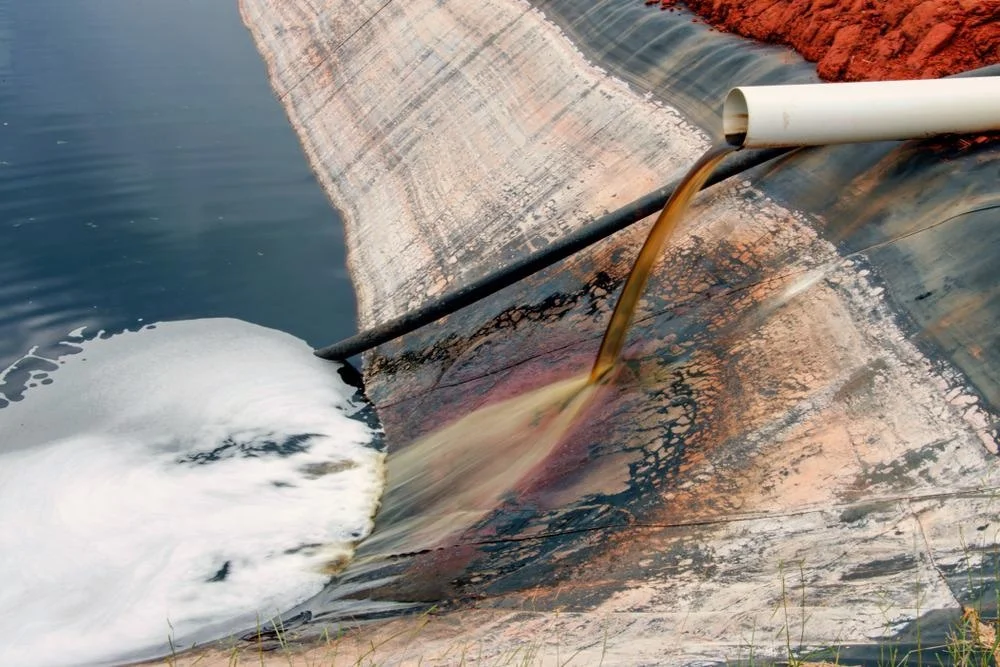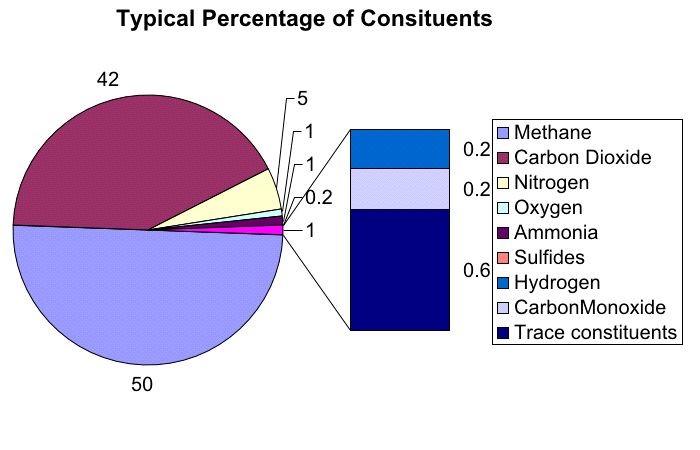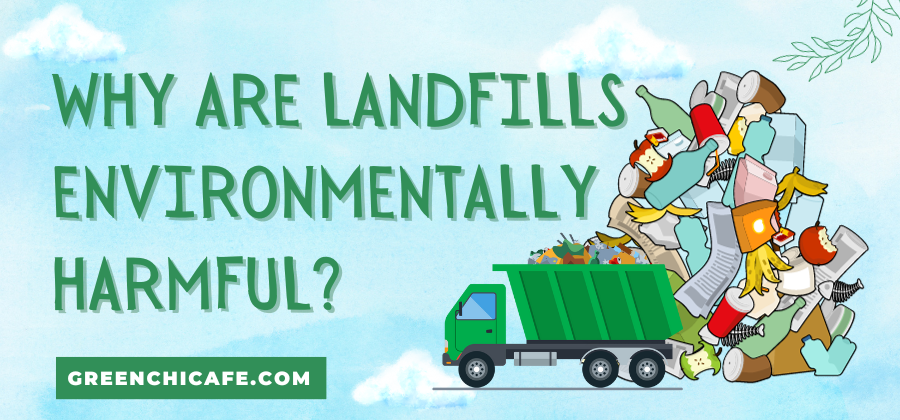Last Updated on June 5, 2024 by Annie Baldwin
Landfills may seem like an easy solution for trash disposal, but they come with significant environmental risks.
This article explores why landfills leak toxic chemicals and pose dangers to our health and planet.
Why Are Landfills Environmentally Harmful?

Landfills are environmentally harmful for three main reasons.
First, they can contaminate groundwater and soil due to the presence of hazardous chemicals and toxic leachate.
Second, landfills generate greenhouse gases like methane that contribute to climate change.
Finally, landfills can also create unpleasant odors and attract vermin, while rendering surrounding land unusable.
The combination of water and air pollution, along with other nuisances make landfills a significant environmental concern.
Key Points
- Landfills can leak toxic chemicals into groundwater and soil.
- Methane produced by landfills contributes to climate change.
- Landfills create unpleasant odors and attract vermin.
Our Opinion
As environmental experts, we believe landfills pose a major hazard to the environment.
The potential for groundwater contamination alone is enough to make us wary of landfills.
When you add in issues like methane emissions and odors, it becomes clear that landfills are unsustainable and dangerous from an ecological perspective.
We need to reduce waste and divert more towards recycling to limit our reliance on landfills.
Why Landfills Leak Toxic Chemicals

Landfills are not as contained as you may think. Over time, landfill liners and containers inevitably degrade, allowing toxic liquids called leachate to seep out. Leachate forms when rain passes through the landfill, picking up a toxic brew of chemicals and microbes. This contaminated liquid then leaks into groundwater, rivers, lakes, and oceans. According to the EPA, all landfills eventually leak as their liners deteriorate.
Leachate contains dangerous substances like mercury, lead, VOCs, and carcinogens. When these toxins enter water supplies, they can cause cancer, organ damage, and reproductive issues in both humans and wildlife. The EPA reports that half of the landfill leaks go undetected for years, allowing poisons to silently spread.
In addition to leachate, landfill gas emissions directly release toxins into surrounding soils and air. These emissions contain cancer-causing volatile organic compounds (VOCs) along with greenhouse gases like methane. Nearby communities bear the brunt of these pollutants.
How Landfills Contaminate Groundwater
Landfills pose a severe threat to groundwater through leaching of toxins. Rainwater filters through waste, collecting contaminants that then drain into groundwater aquifers. Once pollutants enter groundwater, they spread unseen over wide areas.
The types of toxins contaminating groundwater near landfills include:
- Heavy metals like lead, mercury, and arsenic
- Chlorinated hydrocarbons from industrial waste
- Benzene and other carcinogenic organic compounds
- Acids, pharmaceuticals, and pesticides
Over half of the American landfills lie over aquifers used for drinking water. The EPA estimates that 90% of our nation’s groundwater contains some landfill-derived pollution. Contaminated water becomes undrinkable and unusable.
Groundwater contamination also seeps into soils, accumulating in crops and animal products we consume. Toxins spread through the entire surrounding ecosystem.
While clay liners temporarily prevent leaching, all landfill liners eventually crack and decay. Modern landfills have a life expectancy of only 30-50 years before liners break down. At this point, groundwater pollution accelerates.
Why Landfill Gas Is Dangerous

Landfills produce toxic and explosive gases that threaten human health and the environment. As organic waste like food scraps or paper decomposes, it releases methane and other landfill gases.
Dangers from landfill gas include:
- Asphyxiation or poisoning if gas migrates into nearby buildings
- Gas pipeline explosions, since methane is highly flammable
- Vegetation die-off from gas emissions
- Contributing to climate change, because methane is a potent greenhouse gas
Landfill gas contains over 500 different compounds, many linked to cancer or other health problems. The gas can migrate underground, surfacing miles away from the landfill site. It seeps into soil, groundwater, and the air we breathe.
U.S. landfills are the third largest source of methane emissions, releasing over 115 million tons of methane and carbon dioxide in 2015 alone. Methane traps heat 86 times more effectively than CO2 over a 20-year period. Uncontrolled landfill gas is a major driver of climate change.
To prevent explosions and migration, landfill gas must be continually monitored and collected in recovery systems. But no system is 100% effective – gas still leaks, threatening nearby communities. The only lasting solution is phasing out organic waste disposal in landfills through composting and recycling.
How Landfills Increase Air Pollution
Landfills emit a toxic mix of air pollutants that threaten human health. As waste decomposes, landfills release:
- Landfill gas containing carcinogens like benzene and vinyl chloride
- Particulate matter that can cause respiratory disease
- Nitrogen oxides that contribute to smog formation
- Sulfur dioxide that can cause asthma and breathing issues
Other air pollutants come from landfill operations like truck traffic, heavy machinery, and soil disruption. Hundreds of chemicals evaporate from landfills into the air, many of them linked to cancer, birth defects, and neurological damage.
People living near landfills face increased health risks like asthma, chronic bronchitis, emphysema, and other respiratory illnesses. One study found a prevalence of wheezing and asthma 50% higher in children near landfills. Another saw increased risks for lung and laryngeal cancers.
Air pollution from landfills also contains heavy metals like mercury and lead that spread for miles, contaminating soil, plants, and water sources. Toxic air emissions persist for decades after landfills close.
The only solution is reducing waste sent to landfills through recycling and composting. Until we phase out landfills, communities near these facilities will suffer disproportionate health burdens from air pollution.
Why Landfills Harm Wildlife
Landfills disrupt ecosystems and endanger wildlife in several ways:
- Toxic leachate pollutes soil and water sources. This runoff contains heavy metals, cleaning solvents, pesticides, and other dangerous chemicals that bioaccumulate up the food chain.
- Methane and other landfill gases that alter surrounding environments. Methane exposure causes neurological damage, organ failure, and reproductive issues in animals.
- Fires and explosions that destroy habitats and release plumes of toxic smoke. Landfill fires are difficult to extinguish and can burn for months.
- Contaminants that wash downstream during floods, spreading far beyond site boundaries.
- Discarded plastics and litter that entangle or are ingested by animals. Slow deaths from starvation or suffocation result.
- Loud noises, bright lights, and truck traffic that disturb breeding and nesting behaviors. Light pollution alters circadian rhythms.
- Loss of forests, wetlands, and green spaces displaced by landfill construction. Fragmentation drives biodiversity loss.
The environmental damage caused by landfills lasts for generations, even after closure. The only sustainable solution is a zero-waste economy that preserves natural habitats. In the meantime, buffer zones around landfills could help mitigate immediate harm to wildlife.
FAQ
Why Might Landfills Be Harmful to the Environment?
Landfills can contaminate soil and groundwater with toxic chemicals leached from the waste. Landfills also produce methane, a potent greenhouse gas that contributes to climate change. The decomposition of waste can also attract vermin and create unpleasant odors.
What Is Landfill and Why Is It Bad?
A landfill is a site for the disposal of waste materials by burial in the ground. Landfills are bad for the environment because they can leak toxic chemicals into surrounding soil and water, emit harmful gases like methane into the atmosphere, and take up large amounts of land.
What Are the Environmental Disadvantages of Landfills?
The environmental disadvantages of landfills include groundwater and soil contamination from toxic leachate, air pollution from landfill gases like methane, issues with odors and vermin, greenhouse gas emissions contributing to climate change, and taking up large amounts of land.
What Are the Three Main Environmental Issues With Landfills?
The three main environmental issues with landfills are groundwater and soil contamination from toxic leachate, air pollution and greenhouse gas emissions, mainly methane, and unpleasant odors and attraction of vermin like rats and flies.
Conclusion
Landfills are environmentally harmful in several key ways. They can lead to groundwater and soil contamination from the toxic chemicals leached as waste decomposes. Landfills also generate significant amounts of greenhouse gas methane through the decomposition process, contributing to climate change. Additionally, landfills can produce unpleasant odors and attract vermin like rats and flies. With the many toxic substances present, landfills render the surrounding land unusable. Due to these major environmental impacts, landfills present significant environmental hazards.
